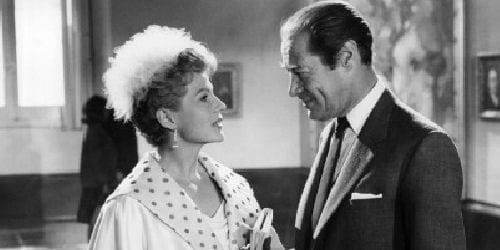
The Happy Thieves aren’t very happy. The chief thief is Rex Harrison, who replaces a Velasquez painting with a duplicate in the home of a duchess (Alida Valli). His accomplices are Rita Hayworth, whom he quickly marries, and a neurotic forger (Gregoire Aslan). A more unscrupulous rival (Joseph Wiseman) hijacks the painting and blackmails the gang into stealing a famous Goya from the Prado on the day of a big bullfight.
Shot in Madrid, this has the trappings of a sleek lark. Alas, the jaunty music by Mario Nascimbene is the only thing larkish about it, and its whistling airs fail to convince. Perhaps it’s the moral weight. A Spanish co-production couldn’t have allowed crime to triumph and the authorities to look like fools, and that’s one reason the plot unfolds in so heavy and sour a fashion. It’s a pity, considering the pedigree. George Marshall had been a major director of comedy, but his last movies feel exhausted. It’s hard to believe Hayworth produced this through her own company, Hillworth Productions (a product of her brief marriage to English director James Hill); her character has nothing to do but fret in a plain and blowzy manner. She used these qualities to sharper effect in The Money Trap a few years later.
Screenwriter John Gay had done well by Hayworth in adapting Terence Rattigan’s Separate Tables a few years earlier. Here he’s giving us the first movie adapted from a novel by Richard Condon (The Manchurian Candidate). In fact, it was from his first novel, The Oldest Confession, and if Condon had worked on the screenplay, its sourness would have had a sharper tang. The basic structure isn’t bad and there are surprises, but details like the title and the music keep trying to insist that the audience must be having a good time while we’re left with a film that doesn’t know its own tone or trust its source. It wants to make its characters likeable in a standard way, something Condon didn’t bother with. Condon shows through in Harrison’s little speech about how most professionals and businessmen are thieves.
This makes a minor international thud in the cool, glamorous, high-style heist genre kicked off by the huge success of Rififi and To Catch a Thief in 1955. Frankly, most of the first decade of knock-offs are slower and more serious than you’d think, as witness Ocean’s 11, Seven Thieves, The Day They Robbed the Bank of England, Topkapi and even Charade. We were well into the 1960s before caper movies really began capering, and it wasn’t until about How To Steal a Million (1966) that nobody had to go to jail or pay for their crimes. All countries had their own systems of censorship or self-censorship, and the hand of convention lay heavy even in shifting times.
This entry in MGM Limited Editions’ made-on-demand DVD-Rs has a greenish tinge and apologizes for having to use “the best available materials”.

![Call for Papers: All Things Reconsidered [MUSIC] May-August 2024](https://www.popmatters.com/wp-content/uploads/2024/04/all-things-reconsidered-call-music-may-2024-720x380.jpg)



